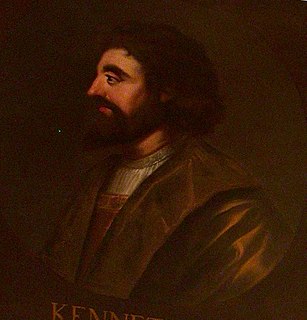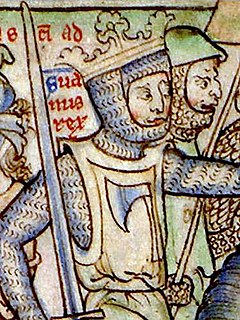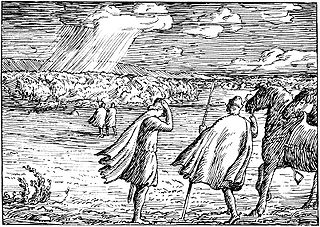
Year 1028 (MXXVIII) was a leap year starting on Monday of the Julian calendar.

Year 995 (CMXCV) was a common year starting on Tuesday of the Julian calendar.

Year in topic Year 1015 (MXV) was a common year starting on Saturday of the Julian calendar.

Sweyn Forkbeard was king of Denmark from 986 to 1014. He was the father of King Harald II of Denmark, King Cnut the Great and Queen Estrid Svendsdatter.

Magnus Olafsson, better known as Magnus the Good, was the King of Norway from 1035 and King of Denmark from 1042, ruling over both countries until his death in 1047.

Malcolm II was King of the Scots from 1005 until his death. He was a son of King Kenneth II; the Prophecy of Berchán says that his mother was a woman of Leinster and refers to him as Forranach, "the Destroyer".

Olaf Haraldsson, known as Olaf Kyrre, ruled Norway as from 1067 until his death in 1093.
Olaf Haraldsson may refer to:

The Battle of Stiklestad in 1030 is one of the most famous battles in the history of Norway. In this battle, King Olaf II of Norway was killed. During the pontificate of Pope Alexander III, the Roman Catholic Church declared Olaf a saint in 1164.

Haakon Ericsson was Earl of Lade and governor of Norway as a vassal under Knut the Great.

Einar Eindridesson Thambarskelfir was an influential Norwegian noble and politician during the 11th century. He headed the feudal lords in their opposition to Olaf Haraldsson.
Dag Ringsson was a Norwegian chieftain from Oppland who participated in the Battle of Stiklestad during 1030 which resulted in the death of King Olaf II of Norway

The Battle of Helgeå was a naval engagement which took place in 1026 between joint Danish and English forces and a combined Norwegian and Swedish force, at the estuary of a river called Helge in Sweden.
Óttarr svarti was an 11th-century Icelandic skald. He was the court poet first of Óláfr skautkonungr of Sweden, then of Óláfr Haraldsson of Norway, the Swedish king Anund Jacob and finally of Cnut the Great of Denmark and England. His poems are significant contemporary evidence for the careers of Óláfr Haraldsson and Cnut the Great.
Svein Knutsson c. 1016–1035, was the son of Cnut the Great, king of Denmark, Norway, and England, and his first wife Ælfgifu of Northampton, a Mercian noblewoman. In 1017 Cnut married Emma of Normandy, but there is no evidence that Ælfgifu was repudiated, and in 1030 Cnut sent her and Svein as regents to rule Norway. However, their rule was considered oppressive by the Norwegians, and they were expelled in 1034. They imposed new taxes and harsh laws that made them unpopular. In William Shakespeare's Macbeth, there is a character called "Sweno, the Norways' king" based on Svein.

The North Sea Empire, also known as the Anglo-Scandinavian Empire, was the thalassocratic domain ruled by Cnut the Great as King of England, Denmark, Norway and parts of what is now Sweden between 1016 and 1035.
Events in the year 1030 in Norway.

Kálfr Árnason was an 11th-century Norwegian chieftain who played a major role both in defeating King Olaf Haraldsson at the Battle of Stiklestad and in bringing back his young son Magnus and raising him to the throne.













